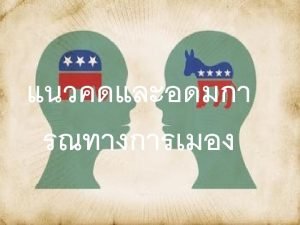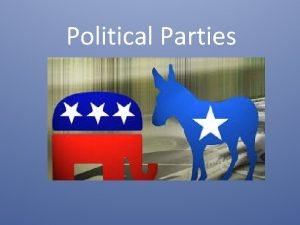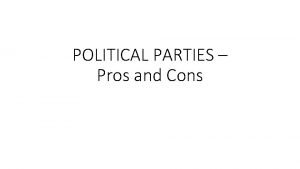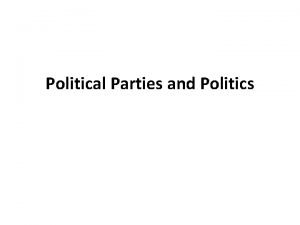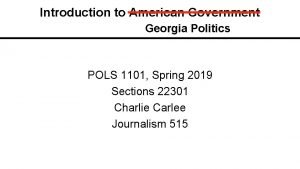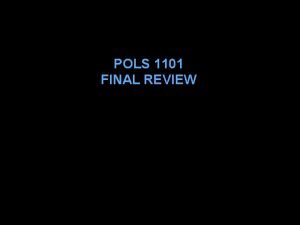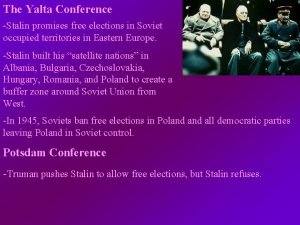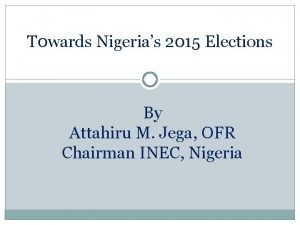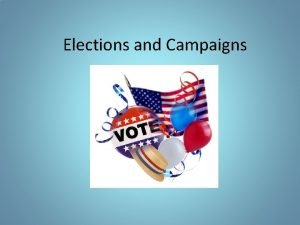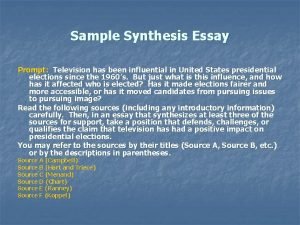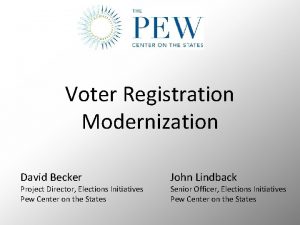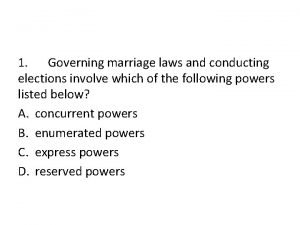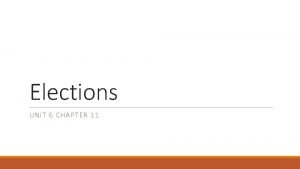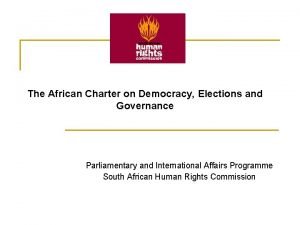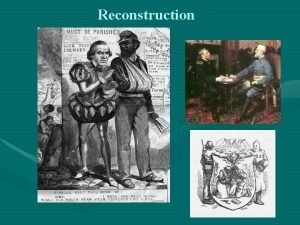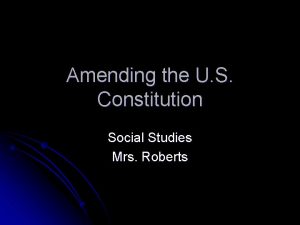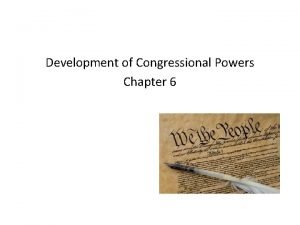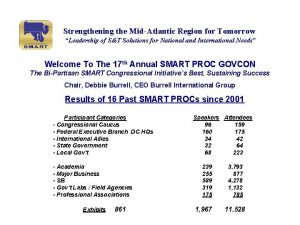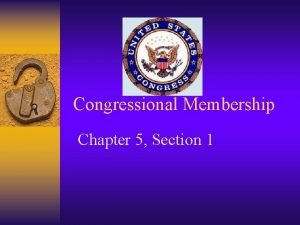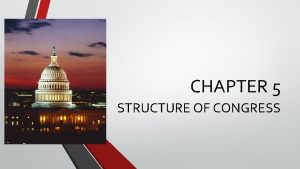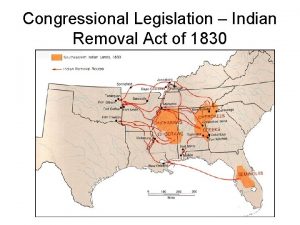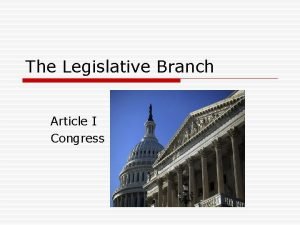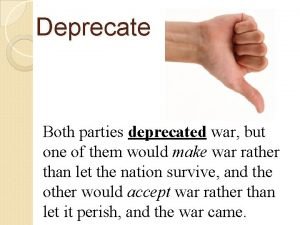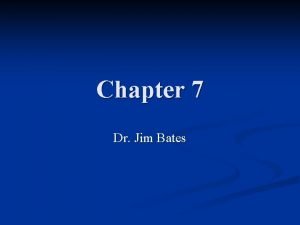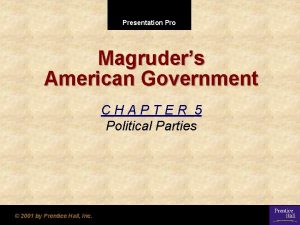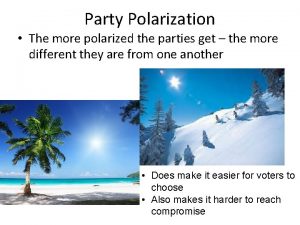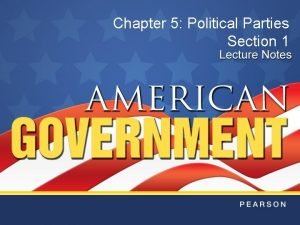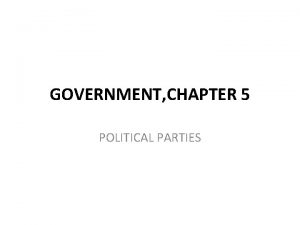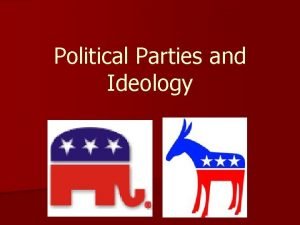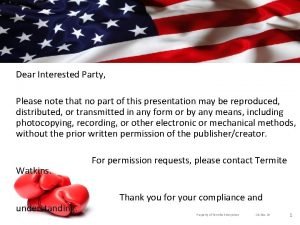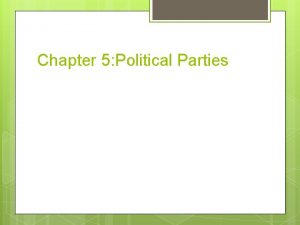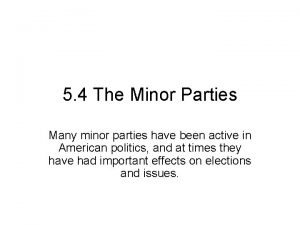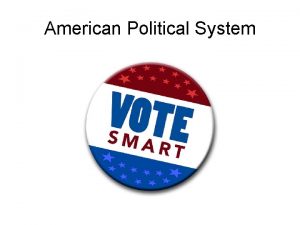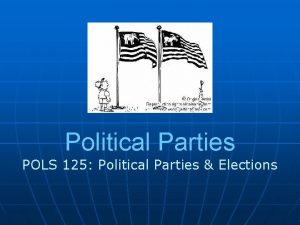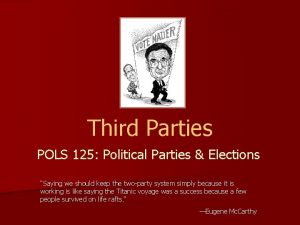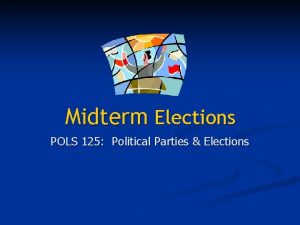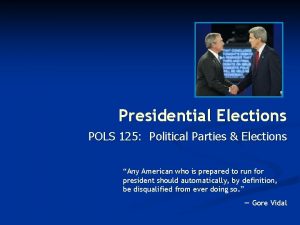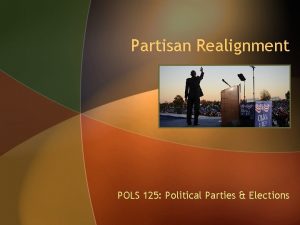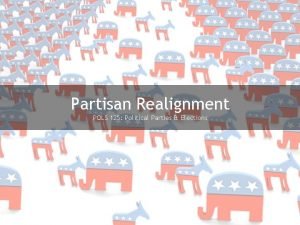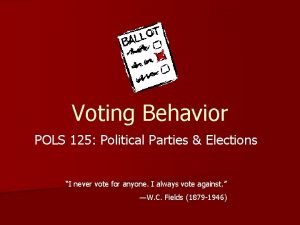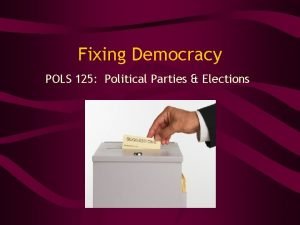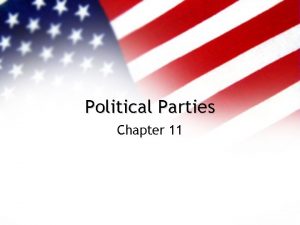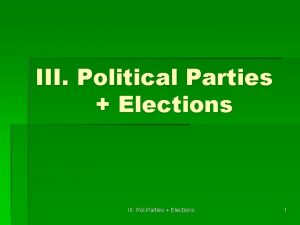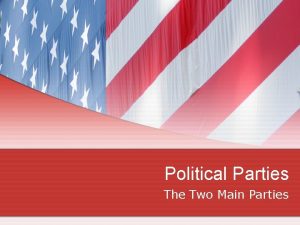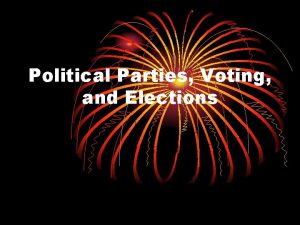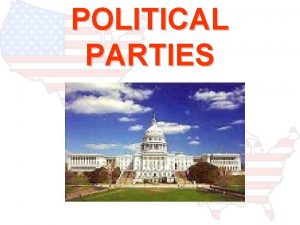Congressional Elections POLS 125 Political Parties Elections We




































































- Slides: 68

Congressional Elections POLS 125: Political Parties & Elections “We would all like to vote for the best man but he is never a candidate. ” — Frank Mc. Kinney “Kin” Hubbard

The Electoral Connection Members of Congress are faced with three primary goals: § § § Getting elected Achieving influence in Congress Making good public policy “Specifically, I shall conjure up a vision of United States congressmen as single-minded seekers of reelection, see what kinds of activities and goals that implies, and then speculate about how congressmen so motivated are likely to go about building and sustaining legislative institutions and making policy” —David Mayhew, Congress: The Electoral Connection (1974)

Who are these people? Peter Moss, Peace & Prosperity candidate for U. S. Senate in 2012 S D N A S R E WEL CH Jane Newton, Liberty Union candidate for U. S. House in 2012 Mark Donka, Republican candidate for U. S. House in 2012 John Mac. Govern, Republican candidate for U. S. Senate in 2012

The Power of Incumbency The chance of unseating an incumbent member of Congress is slim. Most incumbents run for reelection and most of them win by substantial margins. Even in 1994, when an anti-incumbent mood hung in the air, 90% of incumbent House members, and 92% of incumbent Senators were returned to office. In Vermont, n n n PATRICK LEAHY (D) was first elected to the U. S. Senate in 1974. He is currently serving his 6 th term. BERNIE SANDERS (I) was elected to the U. S. House of Representatives in 1990. He served in that office continuously until 2006, when he was elected to the U. S. Senate. PETER WELCH (D) was elected to the U. S. House of Representatives in 2006.

Incumbent House and Senate Members Running for Reelection, 1964 -2010

Incumbency Advantage Redistricting n Decline of party loyalty n Familiarity n Experience n Resources n Year Average Challenger Average Incumbent No. of Winning Challengers 1974 $100, 435 $101, 102 40 1976 $144, 720 $154, 774 12 1978 $217, 083 $200, 607 19 1980 $343, 093 $286, 559 31 1982 $296, 273 $453, 459 23 1984 $518, 781 $463, 070 17 1986 $523, 308 $562, 139 6 1988 $703, 740 $876, 678 7 1990 $462, 546 $631, 025 16 1992 $433, 482 $840, 922 19 1994 $644, 640 $945, 608 34 1996 $1, 070, 162 $1, 040, 878 21 1998 $1, 123, 783 $1, 281, 633 6 2000 $2, 024, 725 $2, 511, 368 6 2002 $1, 595, 805 $2, 141, 672 4 2004 $1, 616, 513 $2, 003, 504 5 2006 $1, 821, 756 $2, 787, 977 22 2008 $1, 971, 197 $2, 354, 163 19 2010 $1, 651, 508 $2, 599, 695 53

Dubious Democracy? n Sky-high incumbency rates. Only five incumbents lost to challengers in 2004—the second lowest in our nation’s history. Nearly nine in ten incumbents were re-elected by “landslide” margins of at least 20 percent. n Landslides. In 14 states, every race was won by a landslide margin of at least 20 percent in 2004. Only four states (all with less than three seats) recorded no landslide wins. n High victory margins. The average victory margin was a whopping 40 percent. Seven of every eight (83%) U. S. House races were won by landslide margins of at least 20 percent in 2004. Only 23 races (5%) were won by competitive margins of less than 10 percent. n Apathy. Nearly one out of every 11 voters skipped over their House race on the ballot. Despite a surge in turnout due to the presidential race, more than 62 percent of eligible voters – nearly two in three – did not vote for a winning House representative. Source: http: //www. fairvote. org/? page=543

Confidence in American Institutions, 2011 "I am going to read you a list of institutions in American society. Please tell me how much confidence you, yourself, have in each one--a great deal, quite a lot, some, or very little? " Source: CNN/USA Today/ Gallup poll, June 9 -11, 2011.

Reelection Rates of House and Senate Incumbents, 1946 -2010

History of Congressional Elections n n Throughout most of U. S. history, congressional elections were “partycentered. ” In the post-World War II era, campaigns have became increasingly “candidate-centered, ” centered around images that are largely independent of party labels.

Creating an Appealing Image


The Candidate-Centered Campaign What factors have influenced the rise of the candidate-centered campaign? 1. THE INSTITUTIONAL FRAMEWORK n n Separation of powers Bicameralism Federalism Primaries 2. POLITICAL CULTURE 3. CAMPAIGN TECHNOLOGY 4. POLITICAL CLIMATE

President The president is elected every four years by the Electoral College 0 4 8 12 16 20 24 Presidential election years draw in higher turnout. House The entire House is elected every two years by voters within each congressional district Senate 1/3 of the Senate is elected every two years by voters within each state 0 2 4 6 8 10 12 14 16 18 20 22 24 Midterm congressional elections have lower rates of voter turnout. 0 6 2 12 8 4 18 14 10 24 20 16 22

President The president is elected every four years by the Electoral College 0 4 8 Holding elections in this way— using and 16 different 20 timetables 24 different constituencies— separates the electoral fortunes of members of Congress from one another, and does little to encourage teamwork in campaigning. 12 House The entire House is elected every two years by voters within each congressional district Senate 1/3 of the Senate is elected every two years by voters within each state 0 2 4 0 6 8 10 12 14 16 18 20 22 24 6 2 12 8 4 18 14 10 24 20 16 22

The institution of Congress supports the electoral needs of its members remarkably well… n n Incumbency provides visibility Congressional privileges (e. g. , franking) allows members to advertise their issue positions back home Political power is decentralized The seniority system ensures that the value of an incumbent appreciates over time

The Candidate-Centered Campaign What factors have influenced the rise of the candidate-centered campaign? 1. THE INSTITUTIONAL FRAMEWORK n n Separation of powers Bicameralism Federalism Primaries 2. POLITICAL CULTURE 3. CAMPAIGN TECHNOLOGY 4. POLITICAL CLIMATE

Incumbent House Members Running for Reelection, 1964 -2006

Candidate-centered campaigns = Incumbent advantage CONSEQUENCES?

The Responsible Party Model Revisited “A strong political party can generate collective responsibility by creating incentives for leaders, followers, and popular supporters to think and act in collective terms. First, by providing party leaders with the capability (e. g. , control of institutional patronage, nominations, etc) to discipline party members, genuine leadership becomes possible. Legislative output is less likely to be a least common denominator—a residue of myriad conflicting proposals—and more likely to consist of a program actually intended to solve a problem or move the nation in a particular direction. Second, the subordination of individual office holders to the party lessens their ability to separate themselves from party actions. Like it or not their performance becomes indentified with the performance of the collectivity to which they belong. Third, with individual candidate variation greatly reduced, voters have less incentive to support individuals and more to support or oppose the party as a whole. And fourth, the circle closes are party-line voting in the electorate provides party leaders with the incentive to propose policies which will earn the support of a national majority, and party backbenchers with the personal incentive to cooperate with leaders in the attempt to compile a good record for the party as a whole” —Morris Fiorina

Some scholars claim that Congress rewards individual responsiveness over collective responsibility. Are stronger parties the answer?


Individual Responsiveness vs. Collective Responsibility What kind of political representation is produced by American electoral politics and how does that representation influence the laws Congress enacts? n n Increasingly, we have seen the insulation of members of Congress from national political forces—which makes it harder and harder to unseat incumbents once they are elected into office. Candidate-centered campaigns allow members to escape responsibility for Congress’ performance as an institution. As the electoral fates of Congress and the president diverge, so does their incentive to cooperate to get things done. The fragmentation of the legislative process and the committee system often leads to gridlock. In short, Congress often provides a kind of hyper-responsiveness to the public’s desires, but without true collective responsibility for their actions.


Incumbent House and Senate Members Running for Reelection, 1964 -2010

An Incumbent Protection Plan Beginning in early 2001, a great tragedy occurred in American politics. It happened quietly, for the most part behind closed doors, and with minimal public input or oversight. The net result of this tragedy is that most voters had their cote rendered nearly meaningless, almost as if it had been stolen from them. Yet the stealing happened without faulty voting equipment, poorly designed ballots, misused voter lists, or campaign finance abuses. It was more like a silent burglar in the middle of the night having his way while American voters slept… And it was legal. Not only was it legal, but the two major political parties, their incumbents, and their consultants were participants in the heist. — Steven Hill, “Behind Closed Doors” (2002)

Reapportionment, as Defined by the U. S. Constitution ARTICLE 1, Section 2, Clause 3: Representatives and direct Taxes shall be apportioned among the several States which may be included within this Union, according to their respective Numbers, which shall be determined by adding to the whole Number of free Persons, including those bound to Service for a Term of Years, and excluding Indians not taxed, three fifths of all other Persons. The actual Enumeration shall be made within three Years after the first Meeting of the Congress of the United States, and within every subsequent Term of ten Years, in such Manner as they shall by Law direct. The Number of Representatives shall not exceed one for every thirty Thousand, but each State shall have at Least one Representative;

The Politics of Apportionment n n n At first there was 1 member of the House of Representatives for every 30, 000 American citizens. Today, with a current population of 300 million, that ratio has increased to about 1: 690, 000. If we were to restore the original ratio between the House of Representatives and their constituents, it would require increasing the size of the chamber from 435 members (where it has been locked since 1911), to 10, 000 members. But remember, Article I of the U. S. Constitution says that “The Number of Representatives shall not exceed one for every thirty Thousand, ” which means there will not be more representatives than that, not that there will not be fewer. Has political representation been diluted by population growth?

States that voted for. . . Electoral Votes Bush in 2000 2004 INDIANA MISSISSIPPI 12 7 11 6 OHIO COLORADO 21 8 20 9 NEVADA NORTH CAROLINA 4 14 5 15 ARIZONA FLORIDA 8 25 10 27 GEORGIA TEXAS 13 32 15 34 Net Gain / Loss -1 -1 -1 +1 +2 +2 +8

States that voted for. . . Gore in 2000 Electoral Votes 2000 2004 NEW YORK PENNSYLVANIA 33 23 31 21 CONNECTICUT ILLINOIS 8 22 7 21 MICHIGAN WISCONSIN 18 11 17 10 CALIFORNIA DISTRICT OF COLUMBIA 54 2 55 3 Net Gain / Loss -2 -2 -1 -1 +1 +1 -6

Electoral Map for 2012


The Original Gerrymander

Cracking and Packing Redrawing the balanced electoral districts in this example creates a guaranteed 3 -to-1 advantage in representation for the blue voters as 14 red voters are packed into the light green district and the remaining 18 are cracked across the 3 remaining blue districts. Source: http: //en. wikipedia. org/wiki/Gerrymandering

Redistricting Software Maptitude® for Redistricting is a special edition of Caliper Corporation’s Maptitude GIS for Windows that includes everything you need to build analyze redistricting plans. As you assign area features to a district, the district boundaries are redrawn and selected attributes are automatically summarized to reflect the district’s characteristics

Majority-Minority Districts o t n o i t u b i r t t!” n o ar c y n r M “ de o m Source: http: //en. wikipedia. org/wiki/Gerrymandering The unusual “earmuff” shape of the 4 th Congressional District of Illinois connects two Hispanic neighborhoods while remaining continuous by narrowly tracing Interstate 294.

The Fight Over North Carolina’s 12 th Congressional District lines have been redrawn several times in response to legal challenges. Gerrymandering based solely on race has been ruled unconstitutional by the US Supreme Court under the Fourteenth Amendment, first by Shaw v. Reno (1993) and subsequently by Miller v. Johnson (1995). Partisan gerrymandering remains legal.

The Texas Redistricting Case Some argue that Lay’s plan strengthened the GOP majority in the House by as many as 5 seats.

Reform in Redistricting


Do these commissions really create more competitive elections? No, says Alan Abramowitz: “During the 2002 -2002 round of redistricting, eight states with a total of 75 House districts used nonpartisan commissions to redraw their district lines or had their lines drawn by the courts. In the 2002 elections, 9 percent of House contests in those states were decided by a margin of less than 10 percentage points compared with 8 percent in all other states. Of the 65 incumbents who ran for reelection in states who districts were redrawn by the courts or nonpartisan commissions, not one was defeated. ”

Does Redistricting Produce Uncompetitive Elections? n n n Scholars argue that “there is little evidence that redistricting generally makes elections less competitive. ” Why? Because party leaders face a tension between incumbent protection on the one hand the growth of the party’s majority on the other. In Texas, the GOP-controlled legislature shifted some Republican precincts out of the Tom De. Lay’s district in order to make neighboring districts more Republican. As a result, De. Lay’s own district is less assured.

n n n Voters are apathetic, turnout is low A rigged and corrupt system ensures the reelection of incumbents Midterm elections don’t matter

Losses by the President's Party in Midterm Elections, 1862 -2010

Erikson’s Theories on Midterm Loss n n Midterm loss as regression to the mean Midterm loss as surge and decline Midterm loss as a referendum on presidential performance Midterm loss as a presidential penalty

Turnout in Presidential and Mid-Term Elections, 1980 -2010 41. 3%

Erikson’s Theories on Midterm Loss n n Midterm loss as regression to the mean Midterm loss as surge and decline Midterm loss as a referendum on presidential performance Midterm loss as a presidential penalty

Tufte Model

Tufte Model

Erikson’s Theories on Midterm Loss n n Midterm loss as regression to the mean Midterm loss as surge and decline Midterm loss as a referendum on presidential performance Midterm loss as a presidential penalty


Confidence in American Institutions, 2011 "I am going to read you a list of institutions in American society. Please tell me how much confidence you, yourself, have in each one--a great deal, quite a lot, some, or very little? " Source: CNN/USA Today/ Gallup poll, June 9 -11, 2011.

Congressional Approval, 1974 -2006 “Do you approve or disapprove of the way Congress is handling its job? ” Americans are far more favorable towards their own member of Congress

Campaigning Governing

The Impact of Campaigning on Governing “Contemporary campaigning has made contemporary government more difficult. Campaigns raise public expectations about government at the same time that they lower trust and confidence in government. They emphasize personal accomplishments in a system designed to curb the exercise of institutional and political power. They harden policy positions in a government system that depends on compromise. They have increasingly brought partisan and ideological rhetoric into the policy-making arena where a pragmatic approach and quiet diplomacy used to get things done. And the candidates have developed a public persona that they continue to pursue once in office, a persona that can get in the way of behind-thescenes compromises on major issues with which they have been associated. ” —Stephen J. Wayne, Is This Any Way to Run a Democratic Election? (2001)

Identifying Problems n n n Low public esteem for the institution of Congress Uncompetitive elections that favor incumbents Highly parochial, individualized, and fragmented politics Pressure exerted through campaign contributions Frequent elections lead to permanent campaigns Campaigns focus on style over substance Prioritize elections over public policy Poor representation (e. g. , lack minority candidates, etc. ) Incumbency advantage leads to long congressional careers Partisan wars over redistricting Policy gridlock Limited ability to punish/reward the institution as a whole

Finding Solutions n n n n Replace partisan redistricting with non-partisan commissions Enact term limits Adopt longer terms in sync with presidential elections Increase the size of the U. S. House of Representatives Use proportional representation Provide public financing of congressional campaigns Encourage stronger parties that impose discipline and unity

Questions… n n Are these solutions likely to address the root cause(s) of the problem? What are the obstacles to effective reform?

Rotation in Office Washington, D. C. in the 19 th century was described as a “swampy, mosquito-infested, rural outpost. ”


The Term Limits Amendment n n n Section A. No person shall serve in the office of U. S. Representative for more than three terms, but upon ratification of the Term Limits Amendment no person who has held the office of U. S. Representative or who then holds the office shall serve for more than two additional terms. Section B. No person shall serve in the office of U. S. Senator for more than two terms, but upon ratification of the Term Limits Amendment no person who has held the office of U. S. Senator or who then holds the office shall serve more than one additional term. Section C. This article shall have no time limit within which it must be ratified by the legislatures of threefourths of the several States.

“Thereafter, within the first 100 days of the 104 th Congress, we shall bring to the House Floor the following bills, each to be given full and open debate, each to be given a clear and fair vote and each to be immediately available this day for public inspection and scrutiny: … 10. THE CITIZEN LEGISLATURE ACT: A firstever vote on term limits to replace career politicians with citizen legislators. ”

Public Opinion on Term Limits “Do you think there should be a limit to the number of times a member of the House of Representatives can be elected to a twoyear term? ” Respondents Yes No Total sample 61% 21% By party Republican Democrat Independent 64 60 58 28 30 33 By ideology Liberal Moderate Conservative 58 64 63 34 30 29 By race White Black 61 61 31 27 By gender Men Women 57 63 35 27



The Citizen-Legislator Joe the Plumber


More Representative is Not Necessarily Better “If these reforms were put into place, would the public suddenly love Congress? We do not think so. Certain reforms, such as campaign finance reform, may help, since they would diminish the perception that money rules politics in Washington. But the main reason the public is disgruntled with Congress and with politics in Washington is because they are dissatisfied with the processes intrinsic to the operation of a democratic political system - debates, compromises, conflicting information, inefficiency, and slowness. This argument may seem odd on its face, so in the next few paragraphs we provide our interpretation of why the public questions the need for democratic processes. ”
 What was one way progressives differed from populists
What was one way progressives differed from populists Wikimedia
Wikimedia Political parties
Political parties Political parties
Political parties The supreme court change
The supreme court change Political parties pros and cons
Political parties pros and cons Brainpop presidential election
Brainpop presidential election Political party
Political party Uga pols 1101
Uga pols 1101 Pols 1101 final exam study guide
Pols 1101 final exam study guide Nadi normal
Nadi normal Steunverband pols
Steunverband pols Stalin promise free elections
Stalin promise free elections Conclusion on elections
Conclusion on elections Presidential elections exploration and announcement
Presidential elections exploration and announcement Ap lang synthesis essay television presidential elections
Ap lang synthesis essay television presidential elections David becker elections
David becker elections Governing marriage laws and conducting elections involve
Governing marriage laws and conducting elections involve “elections are key to democracy”
“elections are key to democracy” African charter on democracy, elections and governance
African charter on democracy, elections and governance Reconstruction refers to the
Reconstruction refers to the Restraint on congressional salaries amendment
Restraint on congressional salaries amendment Truman vs eisenhower venn diagram
Truman vs eisenhower venn diagram With malice toward none meaning
With malice toward none meaning Congressional powers
Congressional powers Development of congressional powers chapter 6 answer key
Development of congressional powers chapter 6 answer key Smart congressional initiative
Smart congressional initiative Section quiz 5-1 congressional membership
Section quiz 5-1 congressional membership Lesson 1 congressional membership
Lesson 1 congressional membership Development of congressional powers chapter 6 answer key
Development of congressional powers chapter 6 answer key Presidential and congressional reconstruction venn diagram
Presidential and congressional reconstruction venn diagram Congressional act of 1830
Congressional act of 1830 How many representatives per state
How many representatives per state Presidential and congressional reconstruction venn diagram
Presidential and congressional reconstruction venn diagram The structure of congress lesson 1 congressional membership
The structure of congress lesson 1 congressional membership Deprecated war definition
Deprecated war definition Why does gatsby stop giving parties?
Why does gatsby stop giving parties? Chapter 5 section 1 parties and what they do
Chapter 5 section 1 parties and what they do Great gatsby jeopardy
Great gatsby jeopardy Innovator role of minor parties
Innovator role of minor parties Chapter 5 section 1 parties and what they do
Chapter 5 section 1 parties and what they do Les parties de la lettre commerciale
Les parties de la lettre commerciale Alloprof introduction texte argumentatif
Alloprof introduction texte argumentatif The smallest unit of election administration
The smallest unit of election administration Define ideological parties
Define ideological parties Gaines techniques parties communes
Gaines techniques parties communes Power point parties
Power point parties Interactions between ais and internal and external parties
Interactions between ais and internal and external parties Corps du dauphin
Corps du dauphin Dear interested
Dear interested Chapter 5 section 3 the minor parties answer key
Chapter 5 section 3 the minor parties answer key Hallócsontok
Hallócsontok Sarah and pam often go to parties
Sarah and pam often go to parties Yang dimaksud dengan pesta dalam kuliner adalah
Yang dimaksud dengan pesta dalam kuliner adalah Splinter parties definition
Splinter parties definition What are the four types of minor parties
What are the four types of minor parties Quality policy
Quality policy Microscope optique
Microscope optique Topic sentence for birthday parties
Topic sentence for birthday parties Réticulum endoplasmique lisse et rugueux
Réticulum endoplasmique lisse et rugueux Horses hate surprise parties
Horses hate surprise parties Plan de texte narratif
Plan de texte narratif Les différentes parties de la lettre commerciale
Les différentes parties de la lettre commerciale Socialist parties
Socialist parties Rounding off rules
Rounding off rules Bina ayat sempit dada
Bina ayat sempit dada Ca 125 valores normales
Ca 125 valores normales Psalm 123-125
Psalm 123-125 Wout ultee
Wout ultee

